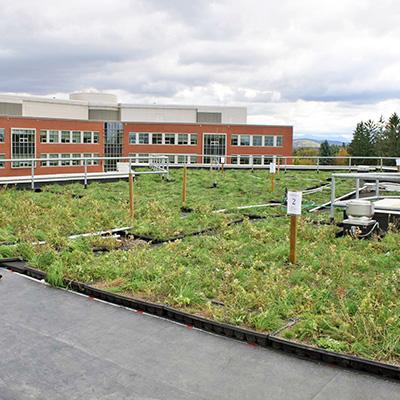Green Roofs: A Sustainable Solution to Management of Storm Water Runoff on Northern Forest Working Landscapes

Impervious surfaces, such as pavement and roofs, in urban ecosystems often result in uncontrolled, rapid runoff of stormwater. During runoff events, the high volume of water deposited into waterways carries pollutants from impervious surfaces and silt from erosion and contributes to elevated water temperatures. Green roofs are a new way to reduce stormwater impacts.
NSRC researchers used 8 rooftop watersheds on the Aiken Center at the University of Vermont that are monitored separately to provide water quality and water flow rates. Four green roof treatments, replicated twice, consisted of standard plants with standard soil, standard plants with alternative biochar soil, alternative plants with standard soil, and non-planted control. In 2013, researchers assessed green roof treatment performance during 5 storm events, and in 2014, they continuously measured water quantity and quality from May 1 to December 31. They also monitored 56 temperature probes.
Findings confirm that green roof treatments had significantly less discharge than controls. Standard plants and soil had half as much discharge as controls, and other treatments had about 25% less than controls. Peak flows were substantially less in vegetative watersheds. Summer temperatures were lower and winter temperatures were higher under vegetated watersheds than under non-vegetated controls. Nitrate concentrations leaving vegetated watersheds were higher than controls, and ammonium concentrations leaving vegetated watersheds were lower than controls. Phosphorus concentrations leaving vegetated watersheds were low but were greater than controls, with standard plants and soil having over twice as much phosphorus discharge as biochar or alternative plants. Biochar as a soil additive shows promise of reducing discharge of nitrogen and phosphorus.
